308 scholarly books by CSLI and 12
have author last names that start with G
308 scholarly books by CSLI and 12
308 scholarly books by CSLI
12 have author last names that start with G have author last names that start with G
12 have author last names that start with G have author last names that start with G
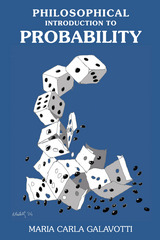
A Philosophical Introduction to Probability
Maria Carla Galavotti
CSLI, 2004
Not limited to merely mathematics, probability has a rich and controversial philosophical aspect. A Philosophical Introduction to Probability showcases lesser-known philosophical notions of probability and explores the debate over their interpretations. Galavotti traces the history of probability and its mathematical properties and then discusses various philosophical positions on probability, from the Pierre Simon de Laplace's “classical” interpretation of probability to the logical interpretation proposed by John Maynard Keynes. This book is a valuable resource for students in philosophy and mathematics and all readers interested in notions of probability.
[more]
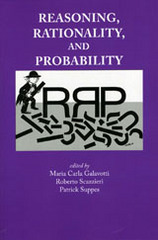
Reasoning, Rationality and Probability
Maria Carla Galavotti
CSLI, 2008
This volume broadens our concept of reasoning and rationality to allow for a more pluralistic and situational view of human thinking as a practical activity. Drawing on contributors across disciplines including philosophy, economics, psychology, statistics, computer science, engineering, and physics, Reasoning, Rationality, and Probability argues that the search for strong theories should leave room for the construction of context-sensitive conceptual tools. Both science and everyday life, the authors argue, are too complex and multifaceted to be forced into ready-made schemata.
[more]
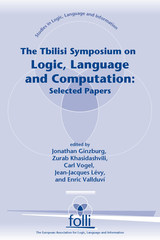
The Tbilisi Symposium on Logic, Language and Computation
Selected Papers
Jonathan Ginzburg
CSLI, 1998
This volume brings together papers from linguists, logicians, and computer scientists from thirteen countries (Armenia, Denmark, France, Georgia, Germany, Israel, Italy, Japan, Poland, Spain, Sweden, UK, and USA). This collection aims to serve as a catalyst for new interdisciplinary developments in language, logic and computation and to introduce new ideas from the expanded European academic community. Spanning a wide range of disciplines, the papers cover such topics as formal semantics of natural language, dynamic semantics, channel theory, formal syntax of natural language, formal language theory, corpus-based methods in computational linguistics, computational semantics, syntactic and semantic aspects of l-calculus, non-classical logics, and a fundamental problem in predicate logic.
[more]
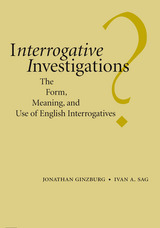
Interrogative Investigations
The Form, Meaning, and Use of English Interrogatives
Jonathan Ginzburg
CSLI, 2001
Interrogative constructions are the linguistic forms by which questions are expressed. Their analysis is of great interest to linguists, as well as to computer scientists, human-computer interface designers, and philosophers. Interrogative constructions have played a central role in the development of modern syntactic theory. Nonetheless, to date most syntactic work has taken place quite separately from formal semantic and pragmatic work on interrogatives. Although there has by now been a significant amount of work on interrogatives across a variety of languages, there exist few syntactic and semantic treatments that provide a comprehensive account of a wide range of interrogative constructions and uses in a single language.
This book closes the gap in research on this subject. By developing the frameworks of Head Driven Phrase Structure Grammar and Situation Semantics, the authors provide an account that rigorously integrates syntactic, semantic, and contextual dimensions of interrogatives. The challenge of providing exhaustive coverage of the interrogative constructions of English, including various constructions that occur solely in dialogue interaction, leads to new insights about a variety of contentious theoretical issues. These include matters of semantic ontology, the quantificational status of wh-phrases, the semantic effect of wh-fronting, the status of constructions in grammatical theory, the integration of illocutionary information in the grammar, and the nature of ellipsis resolution in dialogue. The account is stated with sufficient rigor to enable fairly direct computational implementation.
This book closes the gap in research on this subject. By developing the frameworks of Head Driven Phrase Structure Grammar and Situation Semantics, the authors provide an account that rigorously integrates syntactic, semantic, and contextual dimensions of interrogatives. The challenge of providing exhaustive coverage of the interrogative constructions of English, including various constructions that occur solely in dialogue interaction, leads to new insights about a variety of contentious theoretical issues. These include matters of semantic ontology, the quantificational status of wh-phrases, the semantic effect of wh-fronting, the status of constructions in grammatical theory, the integration of illocutionary information in the grammar, and the nature of ellipsis resolution in dialogue. The account is stated with sufficient rigor to enable fairly direct computational implementation.
[more]
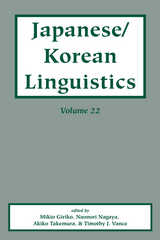
Japanese/Korean Linguistics, Volume 22
Mikio Giriko
CSLI, 2014
Japanese and Korean are typologically similar, with linguistic phenomena in one often having counterparts in the other. The Japanese/Korean Linguistics Conference provides a forum for research, particularly through comparative study, of both languages. The papers in this volume are from the twenty-second conference, which was held at the National Institute for Japanese Language and Linguistics. They include essays on the phonology, morphology, syntax, semantics, historical linguistics, discourse analysis, prosody, and psycholinguistics of both languages. Such comparative studies deepen our understanding of both languages and will be a useful reference for students and scholars in either field.
[more]
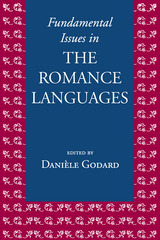
Fundamental Issues in the Romance Languages
Danièle Godard
CSLI, 2010
Fundamental Issues in the Romance Languages compares six Romance languages—Catalan, French, Spanish, Italian, Portuguese, and Romanian—and summarizes the last thirty years of scholarship in the fields of morphology, syntax, semantics, and discourse for each language. The up-to-date analyses in this volume make it essential for undergraduate and graduate students as well as scholars of each language.
[more]
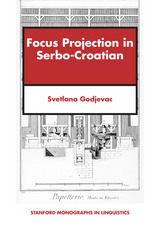
Focus Projection in Serbo-Croatian
Svetlana Godjevac
CSLI, 2004
Research on the English language suggests that the relationship between phonological prominence, word order, and focus—better known as focus projection—is mediated through syntax. This book breaks new ground with its demonstration of how the Serbo-Croatian language shows the workings of this relationship.
Svetlana Godjevac explores the development of focus projection. Further distinguishing her work from the numerous studies of the English language, she analyzes how focus projection in Serbo-Croatian also depends on the semantic type of the prominence bearing element. This volume is an innovative analysis of linguistic theory as well as a study of a lesser examined language.
Svetlana Godjevac explores the development of focus projection. Further distinguishing her work from the numerous studies of the English language, she analyzes how focus projection in Serbo-Croatian also depends on the semantic type of the prominence bearing element. This volume is an innovative analysis of linguistic theory as well as a study of a lesser examined language.
[more]
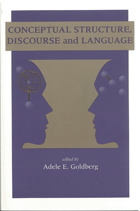
Conceptual Structure, Discourse and Language
Adele Goldberg
CSLI, 1996
This collection of papers is the outcome of the first Conceptual Structure, Discourse and Language conference (CSDL) held at the University of Califronia, San Diego in October 1995. CSDL was organized with the intention of bringing together researchers from both "cognitive" and "functional" approaches to linguistics. The papers in this volume span a variety of topics, but there is a common thread running through them: the claim that semantics and discourse properties are fundamental to our understanding of language.
[more]
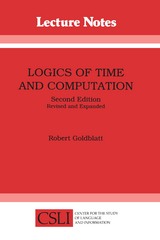
Logics of Time and Computation
Robert Goldblatt
CSLI, 1992
"This is a short but excellent introduction to modal, temporal, and dynamic logic....It manages to cover, in highly readable style, the basic completeness, decidability, and expressability results in a variety of logics of the three kinds considered." -Rohit Parikh, reviewing the first edition in the Journal of Symbolic Logic.
Now revised and significantly expanded, this textbook introduces modal logic and examines the relevance of modal systems for theoretical computer science. Golblatt sets out a basic theory of normal modal and temporal propositional logics, including issues such as completeness proofs, decidability, first-order defiability, and canonicity. The basic theory is then applied to logics of discrete, dense, and continuous time; to the temporal logic of concurrent programs involving the connectives henceforth, next , anduntil; and to the dynamic logic of regular programs.
New material for the second edition extends the temporal logic of concurrency to branching time, studying a system of Computational Tree Logic that formalizes reasoning about behavior. Dynamic logic is also extended to the case of concurrency, intorducing a connective for the parallel execution of commands. A seperate section is devoted to the quantificational dynamic logic. Numerous excercises are included for use in the classroom.
Robert Goldblatt is a professor of pure mathematics at the Victoria University of Wellington, New Zealand.
Center for the Study of Language and Information- Lecture Notes, Number 7
[more]
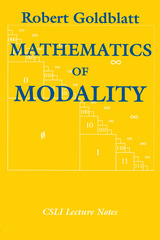
Mathematics of Modality
Robert Goldblatt
CSLI, 1993
Modal logic is the study of modalities—expressions that qualify assertions about the truth of statements—like some ordinary language phrases and mathematically motivated expressions. The study of modalities dates from antiquity, but has been most actively pursued in the last three decades. This volume collects together a number of Golblatt's papers on modal logic, beginning with his work on the duality between algebraic and set-theoretic models, and including two new articles, one on infinitary rules of inference, and the other about recent results on the relationship between modal logic and first-order logic.
[more]
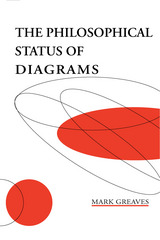
The Philosophical Status of Diagrams
Mark Greaves
CSLI, 2001
The use of diagrams in logic and geometry has encountered resistance in recent years. For a proof to be valid in geometry, it must not rely on the graphical properties of a diagram. In logic, the teaching of proofs depends on sentenial representations, ideas formed as natural language sentences such as "If A is true and B is true...." No serious formal proof system is based on diagrams.
This book explores the reasons why structured graphics have been largely ignored in contemporary formal theories of axiomatic systems. In particular, it elucidates the systematic forces in the intellectual history of mathematics which have driven the adoption of sentential representational styles over diagrammatic ones. In this book, the effects of historical forces on the evolution of diagrammatically-based systems of inference in logic and geometry are traced from antiquity to the early twentieth-century work of David Hilbert. From this exploration emerges an understanding that the present negative attitudes towards the use of diagrams in logic and geometry owe more to implicit appeals to their history and philosophical background than to any technical incompatibility with modern theories of logical systems.
This book explores the reasons why structured graphics have been largely ignored in contemporary formal theories of axiomatic systems. In particular, it elucidates the systematic forces in the intellectual history of mathematics which have driven the adoption of sentential representational styles over diagrammatic ones. In this book, the effects of historical forces on the evolution of diagrammatically-based systems of inference in logic and geometry are traced from antiquity to the early twentieth-century work of David Hilbert. From this exploration emerges an understanding that the present negative attitudes towards the use of diagrams in logic and geometry owe more to implicit appeals to their history and philosophical background than to any technical incompatibility with modern theories of logical systems.
[more]
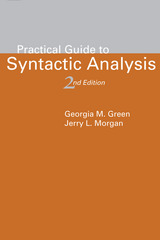
Practical Guide to Syntactic Analysis, 2nd Edition
Georgia M. Green
CSLI, 2001
The Practical Guide to Syntactic Analysis is a resource for students and practitioners of syntax at all levels, addressing matters that textbooks do not explain. Relatively independent sections target issues ranging from the seductive metaphors of generative grammar and the character of linguistic argumentation to practical advice about both getting started and presenting analysis. This second edition adds a reference guide to over sixty grammatical phenomena that every syntactician should be familiar with.
[more]
READERS
Browse our collection.
PUBLISHERS
See BiblioVault's publisher services.
STUDENT SERVICES
Files for college accessibility offices.
UChicago Accessibility Resources
home | accessibility | search | about | contact us
BiblioVault ® 2001 - 2024
The University of Chicago Press









